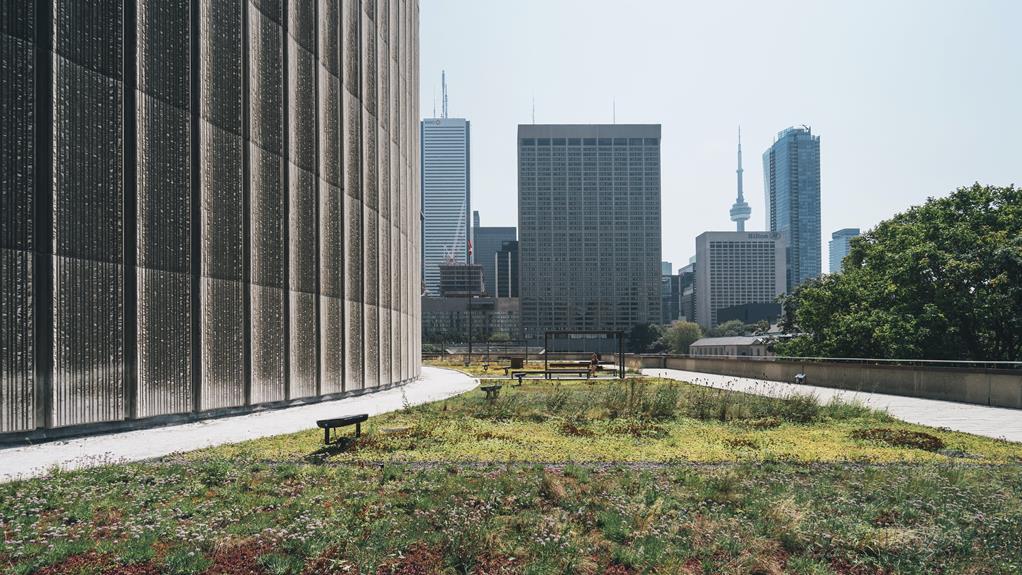Hey there! Are you ready to discover all the amazing benefits of urban green landscaping? Well, you’ve come to the right place! In this how-to guide, we’ll explore the advantages of creating lush green spaces in our cities.
From improved air quality to increased property value, there are so many perks to be gained. By incorporating beautiful gardens, parks, and green areas into our urban landscapes, we not only enhance the aesthetics, but also promote a sense of belonging and community engagement.
So, if you’re looking to create a healthier, happier, and more vibrant city, join us as we embark on this journey of urban green landscaping. Let’s get started!
Health Benefits of Urban Green Landscaping
We believe that urban green landscaping offers numerous health benefits.
Access to green spaces in cities has been proven to have positive effects on both physical and mental health. Public green spaces provide opportunities for physical activity, which can help reduce the risk of chronic diseases such as obesity and cardiovascular conditions. Engaging in outdoor activities in green environments can also improve mental well-being, reducing stress and promoting relaxation.
Additionally, urban green spaces contribute to better air quality by reducing pollution and absorbing carbon dioxide. This not only benefits our health but also the environment.
Incorporating green spaces into urban planning is essential for creating healthier and more sustainable cities, where people can thrive physically and mentally.
Increased Property Value With Green Landscaping
The incorporation of urban green landscaping has shown a direct correlation with the enhanced property value of neighborhoods.
Urban green spaces not only provide health benefits but also contribute to the desirability and value of properties. Parks and public green spaces in urban areas promote physical activity and social interaction, making neighborhoods more attractive and valuable.
These benefits of green spaces have a positive impact on human health and well-being, which can indirectly increase property values. Additionally, urban vegetation, such as trees, helps reduce air pollution and mitigate climate change, factors that can further contribute to the appreciation of property values.
The planning and design of sustainable cities should prioritize the inclusion of urban green spaces, such as pocket parks and other forms of urban greening, to create healthier and more valuable urban land.
Improved Air Quality Through Urban Green Spaces
One of the major advantages of incorporating urban green landscaping is the significant improvement in air quality. Green spaces in cities play a crucial role in filtering pollutants and enhancing the overall quality of the air we breathe.
Here are two key benefits of urban green spaces in relation to air quality:
- Nature-based solutions: Urban green spaces act as nature-based solutions to combat air pollution in cities. Trees and vegetation absorb harmful gases, such as carbon dioxide and nitrogen dioxide, and release oxygen, resulting in cleaner and healthier air.
- Green infrastructure: Incorporating green spaces into urban design provides a sustainable solution to improve air quality. By creating green infrastructure, such as parks, gardens, and green roofs, we can reduce air pollution and enhance the overall health and well-being of urban communities.
Reduction in Urban Heat Island Effect With Green Landscaping
How can urban green landscaping effectively reduce the urban heat island effect?
Urban green landscaping offers a range of benefits that contribute to the reduction of the urban heat island effect.
By introducing green spaces into the urban environment, we can mitigate climate change and create a healthy and sustainable living environment.
Green spaces help to lower urban temperatures by providing shade and cooling through evapotranspiration.
This reduces the need for air conditioning and lowers energy consumption, resulting in decreased greenhouse gas emissions.
Additionally, green spaces improve air quality by absorbing pollutants and releasing oxygen, creating a cleaner and healthier urban environment.
Community Engagement and Social Benefits of Urban Green Spaces
We actively engage communities through urban green spaces. These green spaces offer numerous benefits to urban residents, fostering community engagement and enhancing social well-being.
Here are two key reasons why urban green spaces are essential for community engagement and social benefits:
- Improved health and well-being: Access to green spaces has been linked to improved mental health and well-being. These spaces provide opportunities for physical activity, stress reduction, and psychological restoration. By promoting healthier lifestyles and offering spaces for relaxation and recreation, urban green spaces contribute to the overall well-being of individuals and communities.
- Social cohesion and connection: Green spaces serve as public gathering places, bringing people together and fostering a sense of belonging. Parks and other urban green spaces provide opportunities for community events, social interactions, and cultural activities. They promote social cohesion, reduce social isolation, and create spaces where residents can build relationships and strengthen community ties.
Conclusion
Urban green landscaping offers a myriad of benefits that positively impact our health, property value, air quality, and community engagement.
By incorporating green spaces into our cities, we can create a harmonious blend of nature and urban living, resulting in a healthier and more vibrant environment for all.
So let’s embrace the advantages of urban green landscaping and witness the wonders it can bring to our communities.




